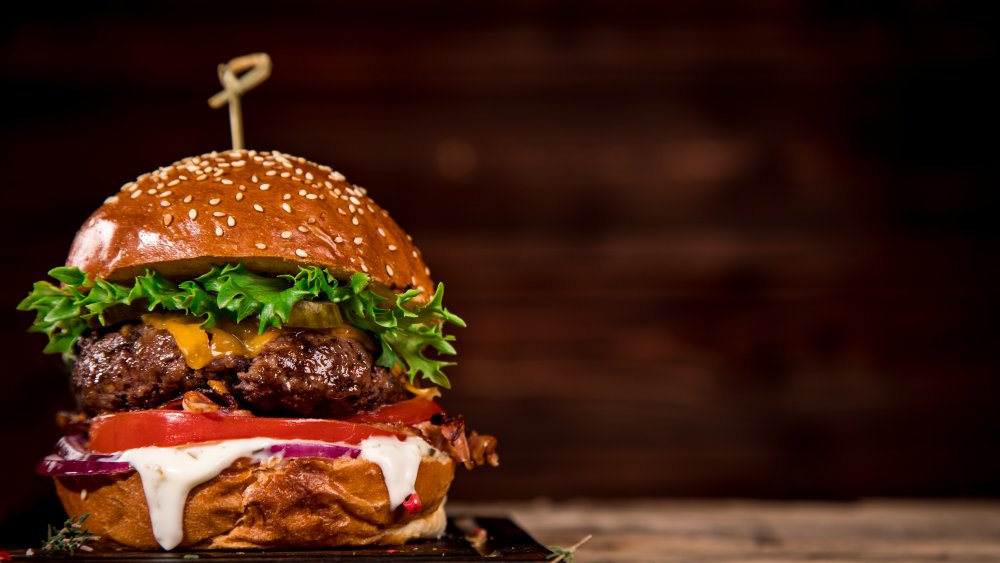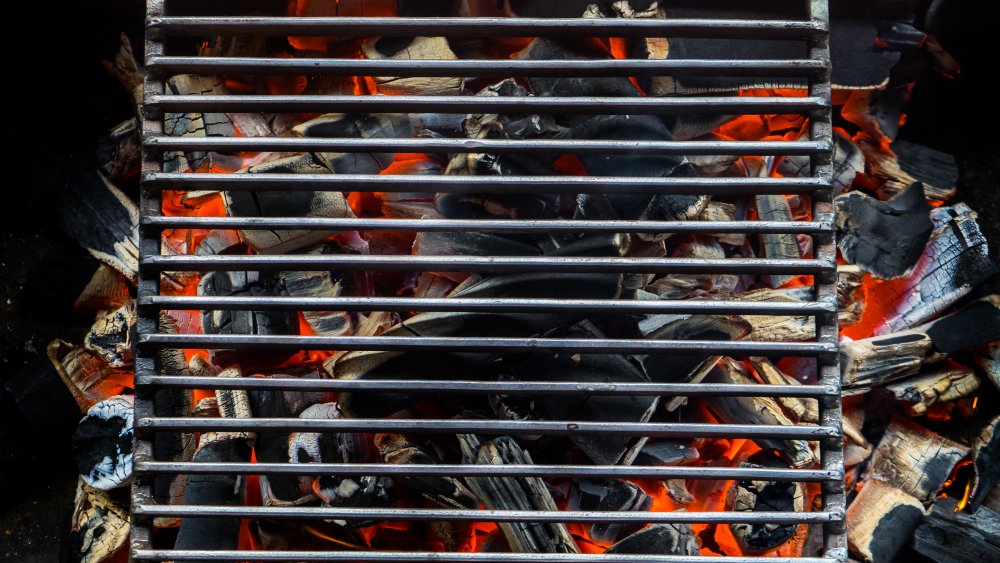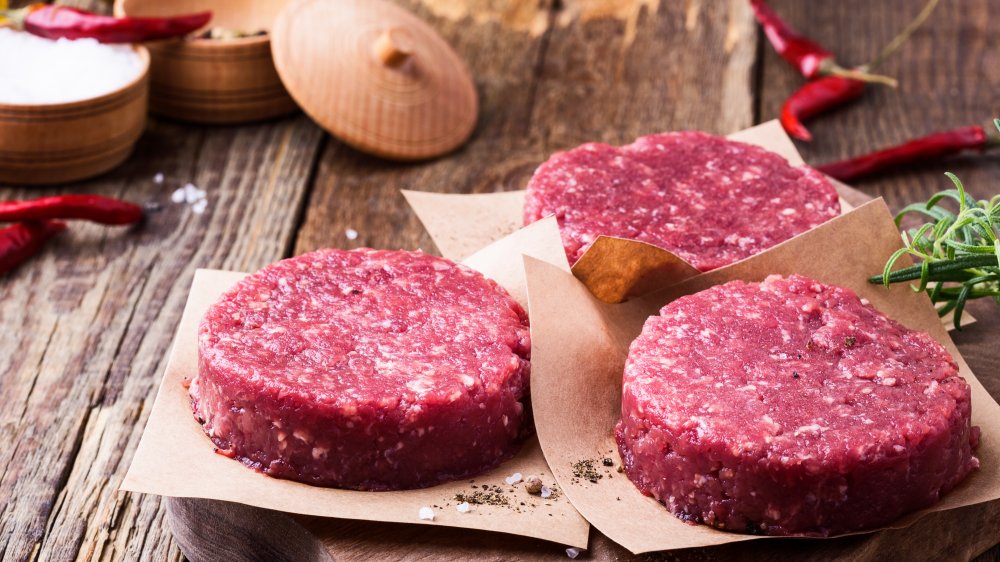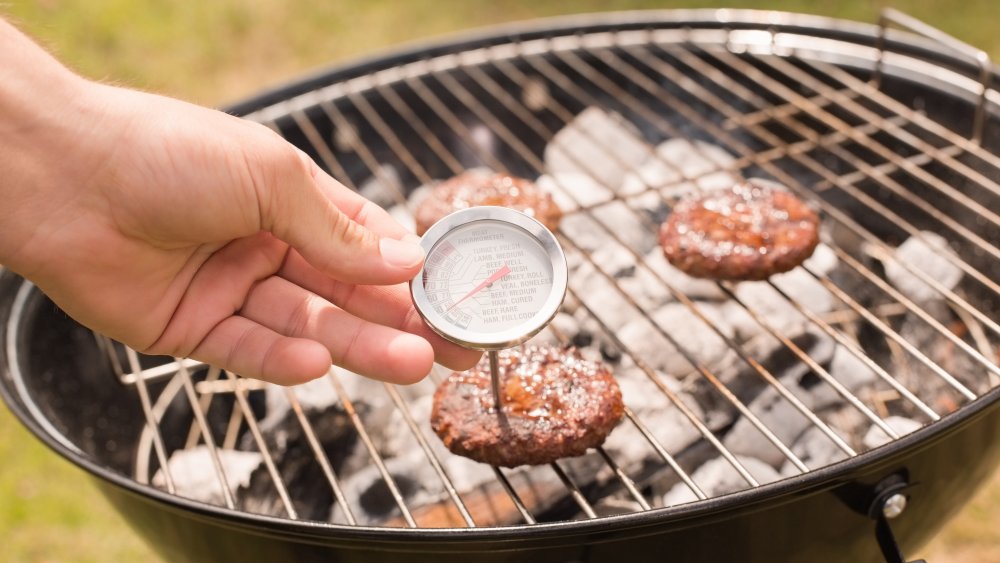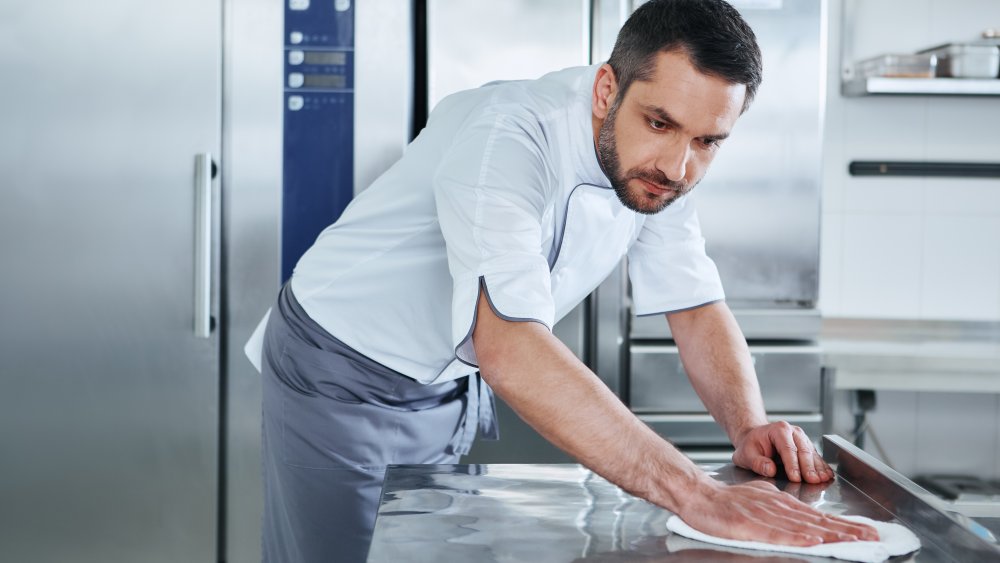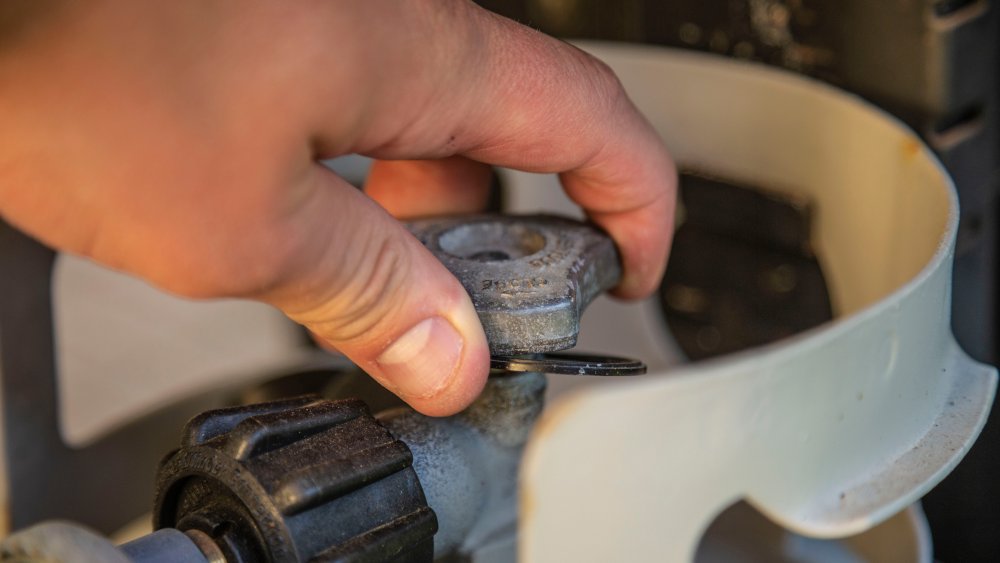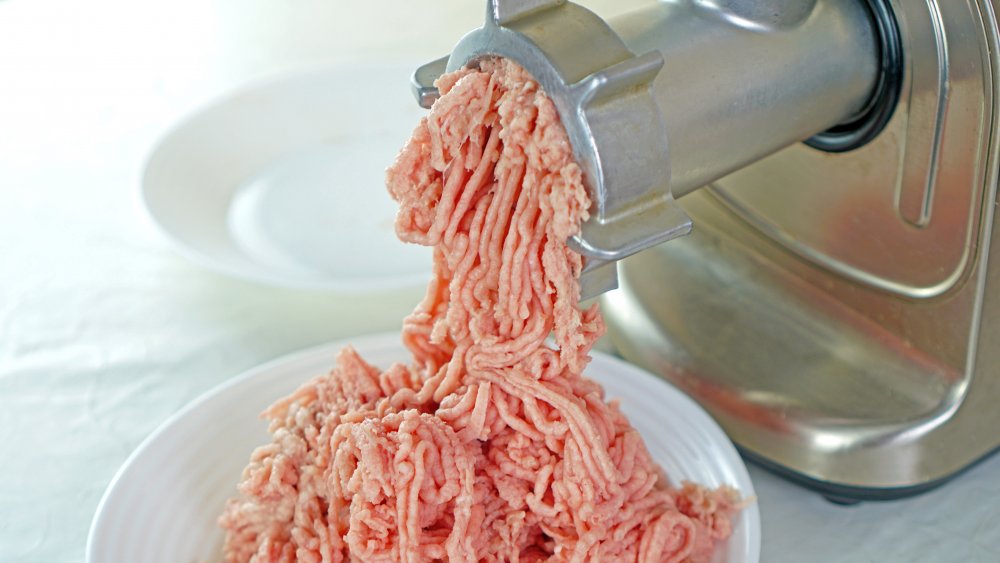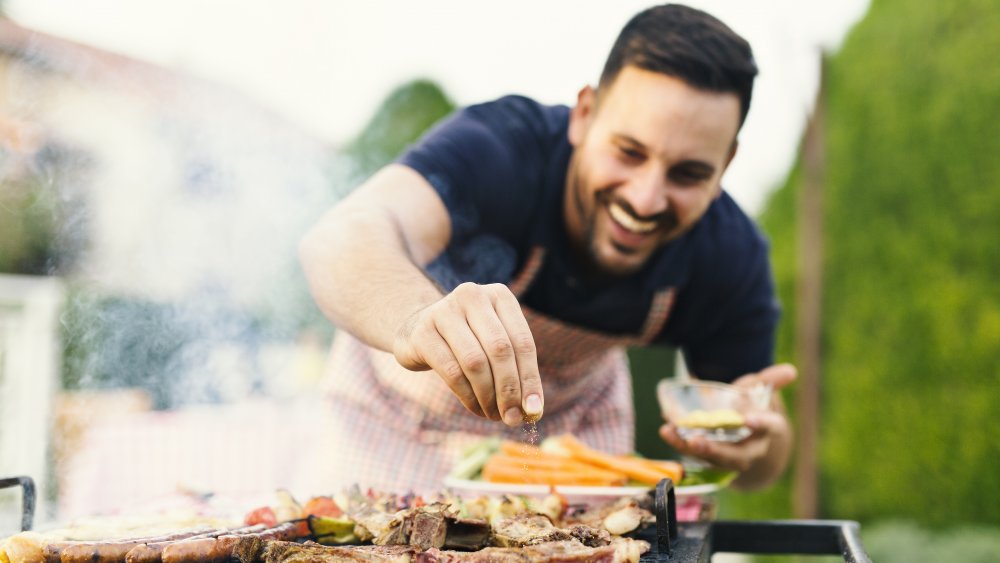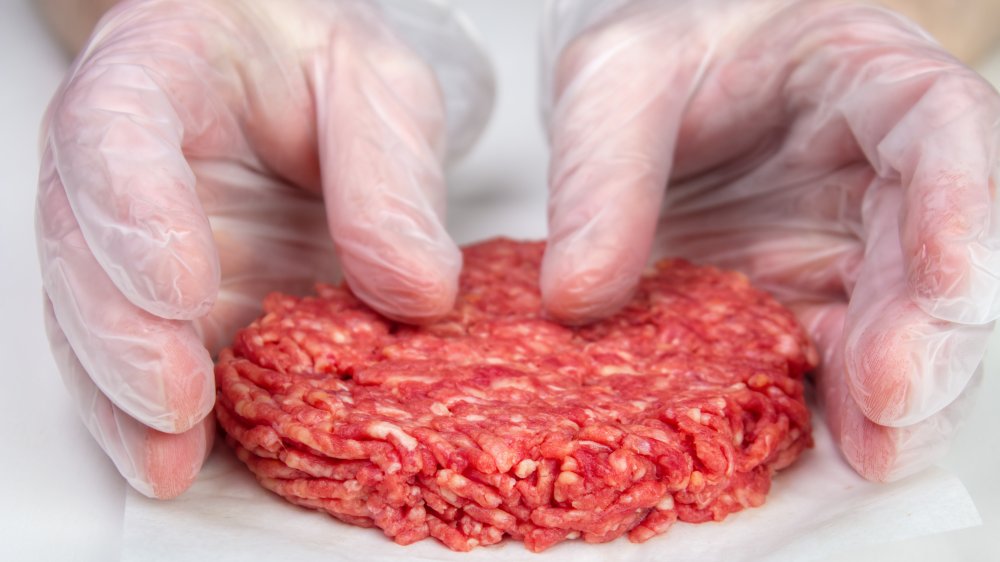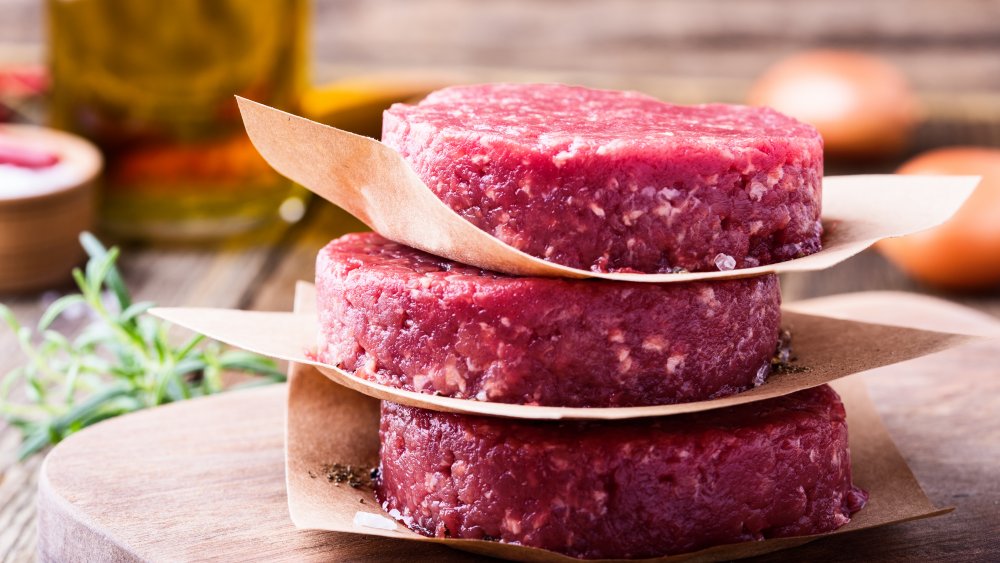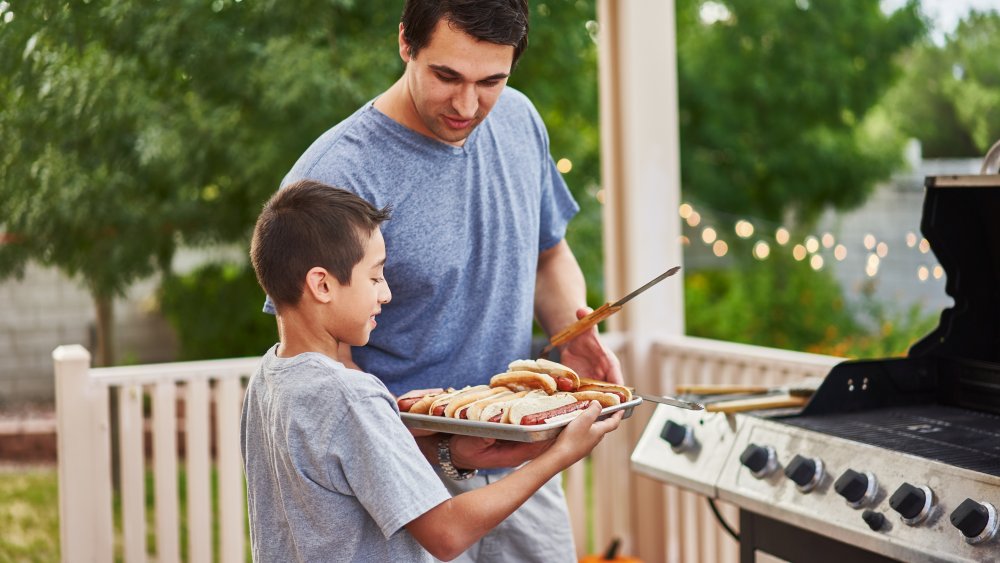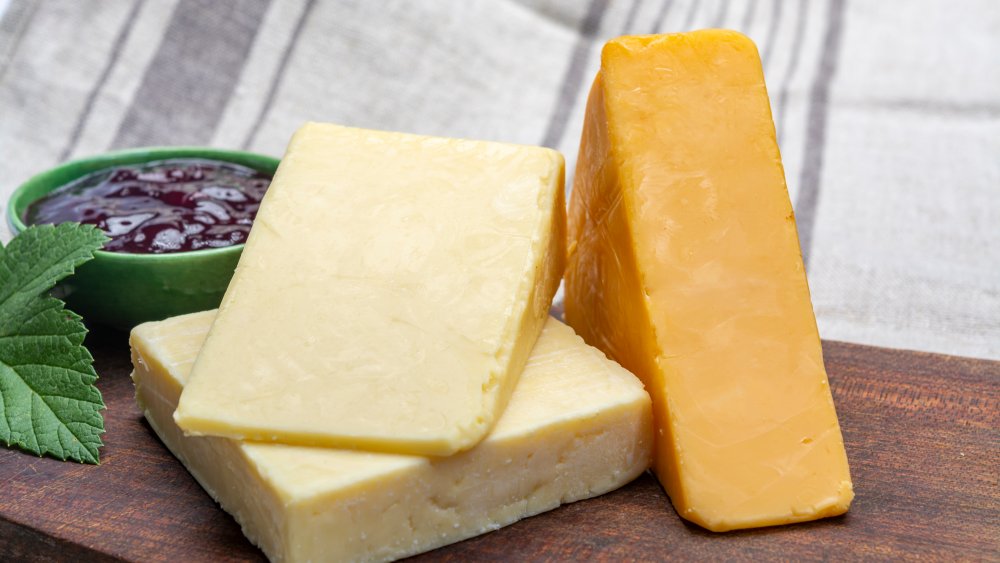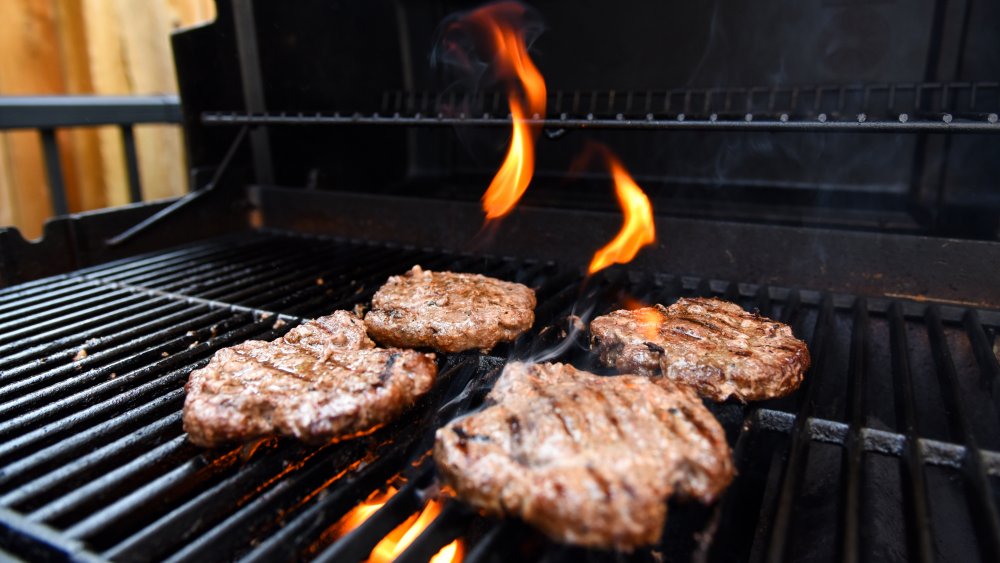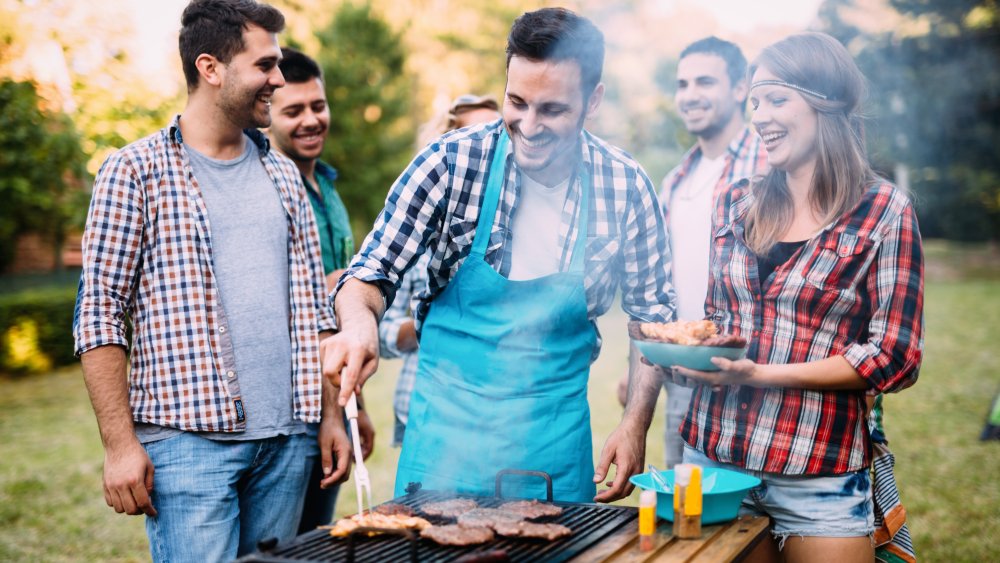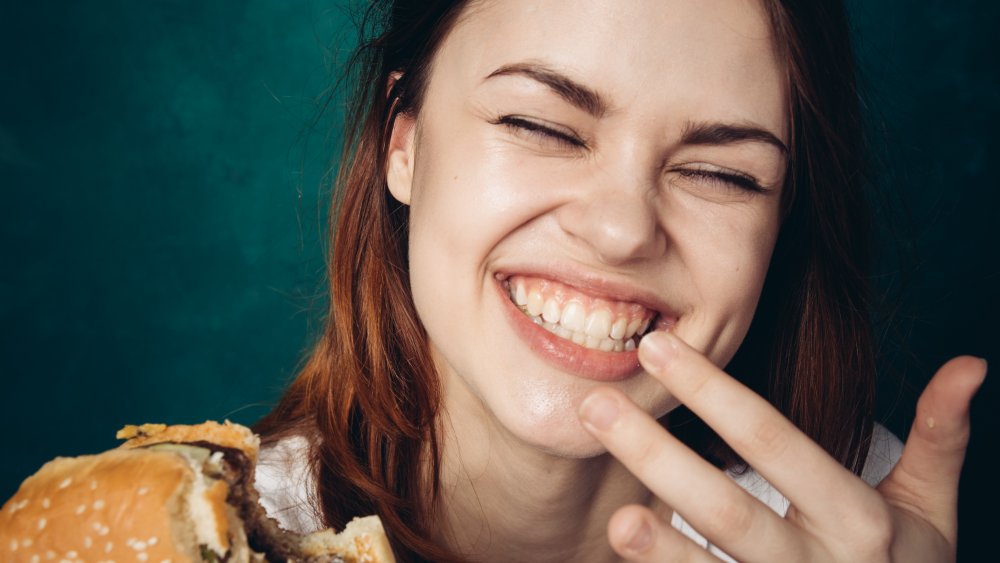14 Mistakes Everyone Makes When Cooking Burgers
Grilling up burgers is a summertime staple in many parts of the country. And really, how hard can it be? Buy some random ground beef at the store, throw together some burger patties, toss them on the grill, and boom, you've got burgers.
But in reality, grilling burgers isn't quite this simple. Sure, if you follow the above steps, you will end up with something that you and your backyard barbecue guests can eat. But that doesn't necessarily mean it will taste good, nor does it mean that it's totally safe to eat. If you've ever choked down a bone-dry burger (or slathered one in sauce just to make it palatable), then you know what we're talking about here.
You might think you're a burger pro, but chances are you're making at least one of these common grilling mistakes. It's never too late to learn some new grilling tricks. Plus, who doesn't want the most delicious burgers possible? Even if you've been grilling for years, you can always make tweaks and improvements.
Not cleaning your grill before you cook your burgers
When you're about to throw some burgers on the grill, you're probably already hungry, maybe even bordering on hangry. Maybe you spent the day engrossed in pulling weeds in the garden or tackling a long-overdue DIY house project. Either way, you're starving.
But just because you've seasoned your meat and formed it into patties doesn't mean you're ready to get grilling. It's important to take a few minutes and thoroughly clean your grill, whether you're using a charcoal or gas grill (or even an electric griddle, for that matter). Think of it this way: You wouldn't toss raw meat into a gross, dirty, charred pan and then put it in the oven, would you? You should hold your backyard barbecue grill to the same standard. Even if your grill has a cover or lid, it still sits outside in the elements, collecting dust, dirt, yard debris, and other nasties. Plus, that charred residue can actually harbor bacteria and cause your burgers to stick to the grates, making it much more difficult for you to flip them or pull them off the grill in one piece.
There are a number of different ways to clean your grill, ranging from practically zero effort on your part (soaking the grill grates in hot, soapy water) to a quick-and-dirty scrubbing or washing if you need your grill to be clean ASAP.
Defrosting your burger meat at room temperature
If you're like many home grillers, you buy a little extra burger meat each time you're at the store to stash in your freezer — we all know how much easier this makes meal-prepping. But when burger night rolls around in your household, how are you defrosting your frozen meat? If you're the type of person who simply sets it out on the counter in the middle of the morning so that it's ready by dinnertime, you might want to reconsider.
Food safety guidelines from the U.S. Department of Agriculture's Food Safety and Inspection Service say that the safest way to defrost meat is either in the refrigerator or by running it under cold water in the sink. Why? This prevents any part of the chunk of frozen meat from reaching a temperature where bacteria can grow and thrive. It takes a little bit more planning, yes, but it means that you can rest easy knowing your meat won't get anyone in your family sick. If you absolutely must speed up the defrosting process, you can thaw your beef in the microwave. And whatever you do, don't leave your meat out at room temperature for more than two hours.
Not using a meat thermometer when you cook burgers
Sure, we all have our burger preferences — well-done, medium, medium-rare, rare, still mooing. Technically speaking, you should never, ever eat raw or undercooked beef, as it may contain harmful bacteria like E. coli. Instead of cutting into each individual burger to see if it's done, consider investing in a meat thermometer. This handy kitchen gadget removes all the guesswork out of cooking burgers and other meats, since you can simply insert the probe and learn the meat's temperature in a matter of seconds.
For ground beef, you really need to be cooking your burgers to an internal temperature of 160 degrees Fahrenheit, per the USDA's guidelines. And if you're throwing some other meats on the grill at the same time, you should know that the recommended cooking temperatures vary greatly for other types of meat. Chicken, for instance, needs to reach a temperature of 165 degrees Fahrenheit, while salmon only needs to reach 145 degrees. Make sure you're using the thermometer properly by inserting it into the thickest part of the meat and ensuring it doesn't poke out the other side or touch any of the grill elements.
Not sanitizing your kitchen after handling raw meat
How many of us have slapped together some burger patties, then promptly spent the rest of the evening outdoors grilling, eating, having a few drinks, and catching up with friends and family? But even though cleaning may be the last thing on your mind while grilling, it's a really important piece of the puzzle.
Once you've placed your burgers on the grill, bring the plate and any utensils you used back inside. Put them in the dishwasher immediately or wash them in the sink with hot, soapy water. While you're at it, be sure to sanitize your entire kitchen counter and anything else the raw meat may have come into contact with. Again, you can use hot soapy water to clean surfaces, but the USDA also suggests using a solution made with 1 tablespoon of bleach per gallon of water. You should also wash your hands for at least 20 seconds and encourage any sous chefs to do the same.
Not checking to make sure you have enough propane left before cooking burgers
If you're eager to get started grilling, you probably get right to work forming burger patties and cranking up the heat on the grill. But we've all been there: A few minutes after you start grilling, you notice that the grill isn't hot anymore and your burgers aren't really coking. What gives? You likely ran out of propane. Unless you have a spare propane tank, you've got to figure out how to finish cooking the burgers somewhere else.
While you're getting ready to grill, make checking your grill's propane tank part of your preparation process. Some grills are equipped with built-in weight sensors that can indicate roughly how much propane you have left. In other cases, you may have to take a more DIY approach. You can weigh your propane tank on your bathroom scale, then refer to the printed empty tank weight to calculate how much fuel is left, according to Ferrellgas. You can also pour hot water down the side of your tank, then feel for the level at which the tank is still cool to the touch.
Not buying the right meat for burgers
Ground beef is ground beef, right? Wrong. There's an entire spectrum of ground beef, which you may also refer to as hamburger meat. Ground beef is really just an umbrella term for any cut of beef that's ground up into tiny bits. You can make ground beef out of the cheapest cuts of beef on the market all the way up to the fanciest, most expensive cuts. You can buy pre-made ground beef at the store, or make your own ground beef at home. The options are essentially limitless here. And beyond beef, there are all sorts of other ground meats you can add or use to create a robust, juicy burger.
Before you head to the store, consider your burger goals. Are you trying to tighten up your waistline? Is flavor your top priority? Where will you be cooking your burgers — on a skillet? On the grill? In the oven? You can make burgers out of just about anything — ground turkey, ground pork, salmon, black beans, the list goes on and on. Many cooks recommend mixing a few different types of meat to achieve your desired flavor and consistency. But when it comes to straight ground beef, keep an eye on the ratio of fat to lean meat on the packaging. You'll want to use beef that's on the fattier side, with somewhere between 20 percent to 30 percent fat (via Food & Wine). This will keep your burgers moist and tasty, rather than dry and flavorless.
Overdoing the seasonings and add-ins in your burgers
Blue cheese crumbles. Bacon bits. Parmesan cheese. Breadcrumbs. Garlic powder. Grated cheddar cheese. Steak seasoning mix. Salt. The seasonings and mix-ins for burgers are basically limitless. But before you go overboard and dump the contents of your entire pantry and seasoning rack into the bowl with your ground meat, take a deep breath and step back from the counter. No, really. Unless you legitimately hate the taste of whatever meat you're using, there's really no need to go overboard with seasonings and mix-ins. A burger is meant to taste like a burger, plain and simple. And if you use too many fancy add-ins, you're going to completely overwhelm and mask that burger-y flavor. With too many flavors going on, your tastebuds won't really be able to discern one from the next, making all of those carefully measured add-ins a big waste.
Plus, nobody likes a mouthful of salt and the resulting dry mouth when they're just trying to enjoy a backyard barbecue. Remember that you and your guests can always add more salt, seasonings, and toppings later, but it's almost impossible to remove these ingredients if you accidentally added too much. Basically, the only way to tone down too much seasoning after the fact is to add more meat, if you've got it (via Reddit). Otherwise, you'll probably have to toss your beloved burgers in the garbage and eat leftovers.
Handling your meat incorrectly when cooking burgers
If you're making your own burger patties from ground beef or some other type of meat, you'll want to pay close attention to how you're handling your burgers. More specifically, how much you're handling them. For starters, you really want to take a "get in and get out" approach when you're making burger patties. If you knead or work the meat with your hands too much, you'll end up with tough, chewy burgers, and nobody wants that. You should loosely mix in any seasonings, form your patties, and call it a day. The whole process shouldn't involve much squeezing, wringing, pressing, or pounding. Just some light shaping and that's that.
Similarly, when forming your burger patties, take care not to pack the meat together too tightly. Consider aiming for more of a meatball-like consistency, where the meat is lightly pressed together with just enough force to maintain its shape on the grill. This gives the lean meat and fat some room to breathe and meld during the cooking process. Pack your burgers too tightly and you're also looking at a dense, hard-to-chew end result.
Not making the right burger patty shape
Patty shape can be somewhat of a controversial topic when it comes to making the perfect burger. Do you make them perfectly flat and cylindrical? Use a fancy burger-shaping gadget or press? Start with random blobs of meat, then smash them down onto the grill for "smash burgers?" Generally speaking, the shape of your burger does actually really matter. You want nice, even cooking throughout the burger patty, as well as even cooking across all of your different patties (you don't want one to be so giant that it's raw in the middle while another is so small that it's burnt to a crisp). Consistency is really the key here—consistent size, shape, and density across all of your patties.
There's also a good reason why so many experienced barbecue cooks insist on putting a thumbprint in the middle of each patty. This little trick prevents your burgers from swelling up too much in the center, according to Delish. It's such a simple step but it really helps a burger hold its shape during the cooking process, so go ahead and whip out your thumb and get to work.
Not paying attention when you're cooking your burgers
Unless you're using a smoker to cook your meats over the course of an entire day, grilling isn't really a "set it and forget it" type of cooking method. It's easy to get distracted if you're manning the grill at a party or get together, but you really need to give your burgers your full attention. Most grills have hot spots, or areas that are much hotter (or colder) than others, according to The Kitchn. If you're not already intimately familiar with your grill, this could be a recipe for disaster if you're grilling up a dozen burgers for a crowd. If you turn away from your grill, even for just a minute or two, the patties on these hot spots could become overcooked very quickly, and that's a recipe for disaster.
Even if you are familiar with the hot spots on your grill, you still need to pay attention for the entire duration of the cooking time. Sometimes this means rearranging your burger patties during cooking to make sure none of them sit on the hot spots or cold spots for too long. Other times, it means flipping some patties sooner than others. It's also a good idea to stay right next to your grill from a safety perspective — you can never be too cautious around open flames, hot coals, and/or highly reactive and flammable gas, right?
Adding the cheese to your burgers at the wrong time
Who doesn't love a good cheeseburger? There's literally an entire song written about this juicy, cheesy food because people love it so much. But there's actually an art to making the perfect cheeseburger, and it all comes down to timing. Cheese is fairly delicate and it melts rather easily. Because of this, you really don't want to put your cheese on top of a screaming hot burger inside the grill. Do this and you'll end up with messy cheese all over the place, everywhere except the top of your burger.
Instead, wait to put that slice of cheese until after you remove the burgers from the heat. They'll still be plenty hot to melt the cheese to just the right consistency, and more of it will actually stay on top of the burger than drizzling down onto the plate. Another trick? Place the sliced cheese on the bottom bun, then put your cooked burger patty on top. This gives you the freedom to then put the rest of your toppings and condiments on top of the burger, while still getting a nice melty cheese consistency (via Southern Living).
Not seasoning the burger patties at the right time
You've probably seen or heard that salt has the awesome ability to draw moisture out of foods (just look at the process of salt-curing foods!). Well, this same principle applies when you're making burger patties, which means you want to pay attention to when you're adding salt to your meat.
If you add salt too early and let your burgers sit there for a while, the salt is going to draw out some moisture — moisture that otherwise would have become delicious, flavorful juices. People have conflicting opinions about this, but you're generally safe to add salt to your burgers right before slapping them on the grill (via The Kitchn).
Since other seasonings, like pepper or garlic powder, don't have the same drying properties as salt, you're OK to add them really whenever you'd like. Consider making your own burger seasoning at home, rather than buying an expensive pre-made mix. You really can't go wrong with a mix of smoked paprika, garlic powder, onion powder, black pepper, and just a hint of brown sugar! Plus, you can tweak your personalized burger seasoning to your liking, creating your own signature blend that you can then share with friends and family as gifts around the holidays.
Not cooking the burgers on high enough heat
If you're in a rush to eat, chances are you simply cranked up the grill and placed your burgers on the grate all at the same time. But really, you're doing yourself a disservice by not letting your grill pre-heat before you add the meat (via Saveur).
Pre-heating your grill ensures that the surface is nice and hot before any meat touches down. This high temperature sears the burgers, just like you might do with an expensive steak. Searing creates that wonderful brown crust that's just packed with flavor (not to mention, the sear can help keep juices inside your burger), and it won't happen if you let your burger heat up slowly with your grill.
The reason why seared foods taste so good actually boils down to chemistry. Searing is really just a chemical process, known in the food world as the Maillard reaction, which occurs when a food's sugars and amino acids react to produce flavorful compounds. Yum, thanks science! Now, why didn't they teach us this in school?
Cutting into your burger patties to check for doneness
You've probably watched your dad do this a thousand times. After firing up the backyard grill and throwing on some burgers, he brings a knife outside and cuts into one of the burgers to check for doneness, using the result of this test to help inform whether or not it's time to pull all the burgers off the grill.
Why is this problematic? For one, you're releasing all of those juices you worked so hard to preserve throughout the burger making and cooking process. In addition, checking your meat's color doesn't necessarily tell the whole story, especially if you're using a mix of meats or non-traditional burger meat. With ground beef, yes, you can use the pink color to help gauge your burger's doneness. But this just won't fly with a burger made of ground pork or ground turkey, which both tend to retain some of their pinkish hue even when they're thoroughly cooked. It's better to invest in a simple meat thermometer instead.
